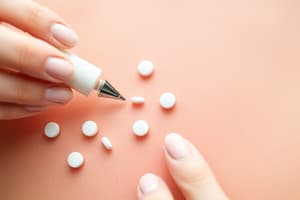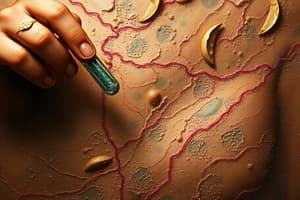Podcast
Questions and Answers
What is the primary factor determining whether a drug will have an effect in a specific location in the body?
What is the primary factor determining whether a drug will have an effect in a specific location in the body?
- The method of drug manufacturing.
- The drug's concentration at that location. (correct)
- The drug's interaction with other medications.
- The patient's age and weight.
What is the definition of MEK in pharmacology?
What is the definition of MEK in pharmacology?
- Minimum Effective Concentration (correct)
- Minimum Effective Kinetic
- Maximum Effective Concentration
- Maximum Excretion Kinetics
When administering a medication, what consideration is most important to ensure the active substance reaches the intended site of action?
When administering a medication, what consideration is most important to ensure the active substance reaches the intended site of action?
- The patient's preferred method of administration.
- The drug's color and texture.
- Ensuring the active substance reaches MEK at the place of effect. (correct)
- The cost of the medication.
What are the two primary categories of drug application routes, based on their intended effects?
What are the two primary categories of drug application routes, based on their intended effects?
A patient requires a medication to treat inflammation in a specific area of their skin. Which application route is most suitable?
A patient requires a medication to treat inflammation in a specific area of their skin. Which application route is most suitable?
What is the primary characteristic of local application routes for drugs?
What is the primary characteristic of local application routes for drugs?
Which local application route is most appropriate for treating localized skin lesions?
Which local application route is most appropriate for treating localized skin lesions?
What is a key characteristic of drugs administered via the epidermal route?
What is a key characteristic of drugs administered via the epidermal route?
A doctor needs to perform an allergy test on a patient. Which drug application route is most appropriate for this purpose?
A doctor needs to perform an allergy test on a patient. Which drug application route is most appropriate for this purpose?
During an intracutaneous injection, into which layer of the skin the substance is inserted?
During an intracutaneous injection, into which layer of the skin the substance is inserted?
Why is it crucial to use sterile ophthalmic preparations when administering medication to the conjunctiva?
Why is it crucial to use sterile ophthalmic preparations when administering medication to the conjunctiva?
A patient has a nasal congestion due to inflammation. Which type of drug is MOST appropriate for intranasal application?
A patient has a nasal congestion due to inflammation. Which type of drug is MOST appropriate for intranasal application?
For what conditions is the buccal (intraoral) route of drug administration primarily used?
For what conditions is the buccal (intraoral) route of drug administration primarily used?
For what conditions is the external ear canal route of drug administration primarily used?
For what conditions is the external ear canal route of drug administration primarily used?
Which part of the anatomy is targeted of drug administration in intrathecal route?
Which part of the anatomy is targeted of drug administration in intrathecal route?
In what emergency situation would a drug be administered via the intracardiac route?
In what emergency situation would a drug be administered via the intracardiac route?
For what condition is the intraperitoneal route of drug administration typically used?
For what condition is the intraperitoneal route of drug administration typically used?
What types of drugs are commonly injected into a joint via the intraarticular route?
What types of drugs are commonly injected into a joint via the intraarticular route?
For what purpose is oxytocic hormone injected into the myometrium via the intrauterine route?
For what purpose is oxytocic hormone injected into the myometrium via the intrauterine route?
What is the application forms in which medications are administered into the vagina via the intravaginal route?
What is the application forms in which medications are administered into the vagina via the intravaginal route?
Which of the following is a characteristic of systemic drug application methods?
Which of the following is a characteristic of systemic drug application methods?
Which of the following is an example of an enteral route of drug administration?
Which of the following is an example of an enteral route of drug administration?
What is a major drawback of oral drug administration compared to parenteral routes?
What is a major drawback of oral drug administration compared to parenteral routes?
In what situation is the sublingual route of drug administration particularly useful?
In what situation is the sublingual route of drug administration particularly useful?
Why is rectal administration commonly used in patients who cannot take oral medication?
Why is rectal administration commonly used in patients who cannot take oral medication?
Which situation MOST appropriate to use parenteral administration?
Which situation MOST appropriate to use parenteral administration?
Which of the following reasons represent a DISADVANTAGE of parental administration?
Which of the following reasons represent a DISADVANTAGE of parental administration?
What is a key advantage of intravenous drug administration?
What is a key advantage of intravenous drug administration?
A patient require an immediate effect. What method of administration would be MOST effective?
A patient require an immediate effect. What method of administration would be MOST effective?
Which of the following is a DISADVANTAGE of intravenous drug administration?
Which of the following is a DISADVANTAGE of intravenous drug administration?
Why should the volume of solution administered via intramuscular injection be limited to a maximum of 5 ml?
Why should the volume of solution administered via intramuscular injection be limited to a maximum of 5 ml?
What is a key reason for applying a maximum of 2 ml of solution via subcutaneous injection?
What is a key reason for applying a maximum of 2 ml of solution via subcutaneous injection?
For what reason the intraosseous injection method is known as a very rare method?
For what reason the intraosseous injection method is known as a very rare method?
What characteristics are typical for drugs administered via the transdermal route?
What characteristics are typical for drugs administered via the transdermal route?
What feature makes inhalation application advantageous for drug administration?
What feature makes inhalation application advantageous for drug administration?
Indicate which of the following is the correct medication-application area combination.
Indicate which of the following is the correct medication-application area combination.
Which of the following drug administration is gas, vapor or aerosol?
Which of the following drug administration is gas, vapor or aerosol?
Flashcards
MEK (Minimum Effective Concentration)
MEK (Minimum Effective Concentration)
The concentration of a drug needed for it to have an effect.
Local application
Local application
Application directly onto the body surface for localized action.
Systemic application
Systemic application
Application where the drug is absorbed into the bloodstream for widespread effects.
Epidermal application
Epidermal application
Signup and view all the flashcards
Intracutaneous application
Intracutaneous application
Signup and view all the flashcards
Conjunctival application
Conjunctival application
Signup and view all the flashcards
Intranasal application
Intranasal application
Signup and view all the flashcards
Buccal (intraoral) application
Buccal (intraoral) application
Signup and view all the flashcards
External ear canal application
External ear canal application
Signup and view all the flashcards
Intrathecal application
Intrathecal application
Signup and view all the flashcards
Intracardiac application
Intracardiac application
Signup and view all the flashcards
Intraperitoneal application
Intraperitoneal application
Signup and view all the flashcards
Intraarticular application
Intraarticular application
Signup and view all the flashcards
Rectal and colonic application
Rectal and colonic application
Signup and view all the flashcards
Intrauterine application
Intrauterine application
Signup and view all the flashcards
Intravaginal application
Intravaginal application
Signup and view all the flashcards
Enteral drug application
Enteral drug application
Signup and view all the flashcards
Parenteral drug application
Parenteral drug application
Signup and view all the flashcards
Transdermal application
Transdermal application
Signup and view all the flashcards
Inhalation application
Inhalation application
Signup and view all the flashcards
Oral/ Per Os Adminstration
Oral/ Per Os Adminstration
Signup and view all the flashcards
Sublingual drugs
Sublingual drugs
Signup and view all the flashcards
Rectal administration
Rectal administration
Signup and view all the flashcards
Parenteral Adminstration
Parenteral Adminstration
Signup and view all the flashcards
Intravenous injection
Intravenous injection
Signup and view all the flashcards
Intramuscular (IM) injection
Intramuscular (IM) injection
Signup and view all the flashcards
Subcutaneous injection
Subcutaneous injection
Signup and view all the flashcards
Intraosseous injection
Intraosseous injection
Signup and view all the flashcards
Transdermal patch
Transdermal patch
Signup and view all the flashcards
Inhalation application
Inhalation application
Signup and view all the flashcards
Study Notes
- Routes for drug application are determined by the drug's target and the condition of the application site.
- When administering drugs, the amounts and application sites should allow the active substance to reach the place of effect in MEK (minimum effective concentration).
Local Application Ways
- Drug affect should be on the body surface
- Route of drug application that includes:
- Epidermal
- Intracutaneous
- Intrathecal
- Intrapleural
- Intraperitoneal
- Intracardiac
- Intraarticular
- Intrauterine
- Intravaginal
- Into the rectum and colon
- On the conjunctiva
- Intranasal and Buccal
Epidermal Application
- Used for localized lesions in accessible areas
- Used for drugs with minimal or no absorption
- Has no or minimal systemic side effects or toxicity
Intracutaneous Application
- Applied to the dermis layer, located just below the epidermis.
- Sterile solutions and test serums for allergy and bacteriology tests are applied
Conjunctiva Application
- Used in various infections
- Ophthalmic preparations must be sterile
Intranasal Application
- Used for diseases of the nasal mucosa and paranasal sinuses
- Applied for anti-inflammatory, vasoconstrictor, local anesthetic drug solutions
- Systemic application is also possible
Buccal (Intraoral) Application
- Used for mouth and gum infections
External Ear Canal Application
- Medication is applied for diseases of the external ear canal or eardrum
Intrathecal Application
- Sterile antibiotic or local anesthetic solutions are administered to create a local effect on the meninges or spinal nerve roots
Intracardiac Application
- In emergency situations or for cardiac resuscitation during cardiac surgery
- Stimulant drugs such as adrenaline administered directly to the heart
Intraperitoneal Application
- In some cases of inflammation of the peritoneum, injections may be made into the abdominal cavity
Intraarticular Application
- In some joint diseases, corticosteroids or antibacterial drugs can be injected into the joint
Rectal and Colonic Application
- Suppository, enema, enema or ointment-shaped preparations are used for superficial lotions of the rectum, hemorrhoids and some diseases of the colon
Intrauterine Application
- Oxytocic hormone is injected into the myometrium to accelerate uterine contraction after cesarean sections
Intravaginal Application
- Medications are administered into the vagina in the form of a pessary
- Drugs in the form of foam and gel are also used to prevent pregnancy
Systemic Drug Application Methods
- Includes:
- Enteral
- Parenteral
- Transdermal
- Inhalation
Enteral Application
- Oral, sublingual, or rectal administration
Parenteral Application
- Intravenous, subcutaneous, intramuscular, or into the bone marrow
- Drugs are not absorbed from the gastrointestinal tract or broken down there
- Injected into a vein or tissue with a sterile syringe and starts to work quickly
Transdermal Application
- Application of the drug to the skin in a special pharmaceutical form
- The drug is absorbed from the skin and enters the circulation
Inhalation Application
- Lipophilic drugs in gas or vapor form pass through the alveolar membrane and enter the general blood circulation by inhalation
Oral Application
- The most commonly used, most practical, and most economical route
- Drugs must pass through the liver after absorption before entering the systemic circulation
- Some drugs may be inactivated and their absorption may not be complete
Sublingual Application
- Used in cases where the drug effect is desired to start very quickly
- Ability to quickly dissolve and create an effect with small amounts
- Highly soluble in fat
- Drugs in the form of small tablets
Rectal Administration
- A local or systemic effect is achieved by absorption from the rectal mucosa
- Administered in the form of suppositories or enemas
- Is more commonly used in patients who cannot take oral medication and in infants
Parenteral Administration Requirements
- Drugs that cannot be absorbed or broken down in sufficient amounts from the gastrointestinal tract if given orally
- Drugs that require rapid onset of effect, such as in emergency situations
- The patient is unconscious, unable to swallow, or experiencing nausea, vomiting, or diarrhea, etc
Disadvantages of Parenteral Administration
- Painful
- Can cause vascular or tissue damage
- Creates psychological stress
- Cannot be administered by the patient alone
- Has disadvantages such as the expensive pharmaceutical form used
Intravenous (IV) Administration
- Drugs that are water-soluble or water-mixable
- Use when rapid effect is desired
- If the patient is unconscious and cannot swallow the drug, this application is preferred
- Bioavailability is usually 100%
- Drug solutions up to 10 ml are injected in 1-2 minutes
- Intravenous infusion is the slow administration of large volumes of drug solutions
Disadvantages of Intravenous Administration
- Only water-soluble drugs can be administered
- Oily solutions and suspensions are not administered intravenously (embolism)
- Drugs with low water solubility may precipitate in the vein if injected rapidly
- Administered drug cannot be retrieved
- High risk of anaphylaxis
- Irritant drugs may cause tissue damage if extravasation occurs
Intramuscular (IM) Administration
- Injecting the drug into the appropriate muscle tissue
- Gluteal or deltoid muscle is usually preferred
- The volume of solution administered should not exceed 5 ml
- Absorption of the injected drug is mostly affected by blood flow in that area
- Massage or exercise increases absorption
Subcutaneous Administration
- The outer surface of the humerus or femur region is often preferred
- Maximum of 2 ml of solution should be applied to prevent pain on the skin
- Irritant drugs should be applied intramuscularly rather than subcutaneously
- Some drugs are placed under the skin in the form of implants or pellets
Intraosseous Injection
- In infants and sometimes adults
- If veins cannot be found, the drug is injected into a suitable bone marrow (sternum) and from there it passes rapidly into the blood
- Very rare method
Transdermal Administration
- Application of the drug to the skin surface for systemic effect
- Highly lipophilic and small dose effective drugs such as nitroglycerin, scopolamine, clonidine, fentanyl, testosterone are applied using a transdermal therapeutic system (patch)
Inhalation Administration
- Alveoli have a very large surface area and a highly permeable membrane, and the blood flow rate in the lungs is also very high
- Pass through the alveolar membrane in the lungs and enter the bloodstream
- Drugs that are gaseous and vaporous (sevoflurane) and have high fat solubility, such as general anesthetics (nitrous oxide), and asthma and COPD drugs are administered
Application Areas of Drugs and Pharmaceutical Forms (Local)
- Epidermal: Ointment, pomade, cream, lotion, powder, soap, solution, liniment, plaster, paste
- Intranasal: Nasal drops and Nasal spray
- Intravaginal: Vaginal suppository, Vaginal tablet, ointment, gel, foam
- Buccal: Lozenge, solution, gargle
- Rectal: Ointment, suppository, enema
- Colon: Enema
- External ear canal: Otic (ear) drops (solution, suspension)
Application Sites of Drugs and Pharmaceutical Forms (Systemic)
- Oral: Solid and Liquid forms
- Solid drug forms: Tablet, dragee, capsule, film-coated tablet, enteric tablet, chewable tablet, packet, effervescent tablet, cachet, pill
- Liquid drug forms: Syrup, elixir, solution, suspension, drop (concentrated solution), lotion, emulsion, extract
- Parenteral: Solution or suspension for injection, emulsion (ampoule, vial, powder for reconstitution), implantation pellet
- Inhalation: Gas, vapor, aerosol, inhaler, nebulizer
- Transdermal: Patch (TTS), ointment
- Other: Nasal spray
Studying That Suits You
Use AI to generate personalized quizzes and flashcards to suit your learning preferences.




